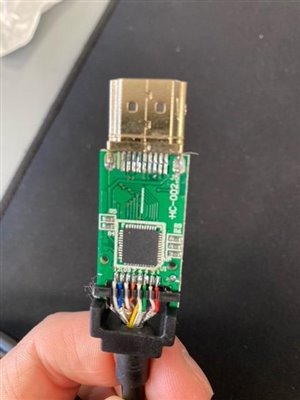
mapj1:
How practical, or not, would it be to bring a supply in via another route - not quite at the level of an extension lead out the window to next door, but back from somewhere nearer the origin. I appreciate that may not be easy, but cables through the airlock door was OK for the MIR space station, so perhaps a test with a supply brought in may be worth it.
Failing that a clean supply may be possible by filtering (example of the sort of thing I mean ) The idea is dirty in one side, clean out the other, and could be in a box beside the DB, or indeed for debugging perhaps a lead with one of these and a plug on one side and 4 way socket on the other end (and adaptable box and some skintop glands if used as a portable test thingy.).
If it is not mains borne but is ESD induced, then yes, perspex screens and unearthed metal frames seem a recipe for possible trouble with static zaps, but I'd expect both sides of the room to be equally affected unless there is some odd source of extra humidity on one side
Mike.
I'm coming in early tomorrow again, before the office starts to fill and i'm going to try unplugging each none passive lead (They seem to have one passive and one none passive due to lack of correct connections on the back of the monitors) and then i'm going to see if the problem still exists both on the scope and in reality (Monitors switching off) After that, it's time to put both rings on one phase and see what happens for the day!
Could it be that the monitors on the affected ring are on a different phase to the main computer in the server room?

AJJewsbury:Could it be that the monitors on the affected ring are on a different phase to the main computer in the server room?
It's not usual to have monitor leads going all the way back to the server room these days - normally the monitors on a desk are connected to a desktop PC or laptop on the same desk and then the connection to the server is via some network system - e.g. Ethernet. At least that's my assumption - so please someone shout if this one is different.
Modern networking systems (e.g. twisted pair Ethernet) have balanced signalling so are pretty immune to differences in Earth potential between the ends.
In the old days there might be terminals on the desk with RS-232 going back to the server room - which could occasionally be a challenge as RS-232 used Earth as a signal reference.
Things on different phases usually isn't a worry - since all the equipment runs on d.c. internally. In fact it's perfectly normal to have a 3-phase supply to a server rack with adjacent equipment or even the two power supplies of a single item of equipment fed from different phases. Some even have twin supplies (for redundancy) with at least one fed by a UPS which can sometimes be entirely out of phase with the mains supply - so you can in effect have six different 'phases' all jostling around in the same area - all perfectly normal.
- Andy.
Morning,
Yes, you are correct, this is just a standard modern day set up with monitor leads plugged in to local PC's under the desks.
Dave


davezawadi (David Stone):
Hi Dave
The symptom is therefore a large current passes through the HDMI screen (which is very thin foil) and it fuses. HDMI with a disconnected screen is not at all reliable, and the fault could damage the Earth referenced power on the cable to the electronics. Somewhere above I think you said there were 4 Ohms between the two ring Earths, which is excessive and cannot be right, I think you just found the 4 Ohms, the bad ring has no Earth to the Steelwork and a significant Earth fault somewhere too. You should find this with a full ring test, and Earth loop measurements, along with testing to find the intermittently faulty piece of equipment. These currents could be circulating Earth current from elsewhere, a clip-on Ammeter will help with that.
Regards
David
Hi,
Yes, someone previously mentioned about the 4 ohms being too high and I immediately realised i'd been a bit flippant about that reading as it is indeed high. I retested it but dropped the socket fronts off and got an improved reading of 1.5 ohms. Still high but maybe not alarm bell high!
Here's a pic of one of the failed leads showing the chip and it's connections. No wires, including any shielding can bypass the chip by the looks of it...
We're about to take you to the IET registration website. Don't worry though, you'll be sent straight back to the community after completing the registration.
Continue to the IET registration site